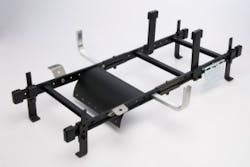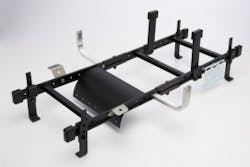Cabling taking center stage at ACUTA
Compiled by Patrick McLaughlin
On Tuesday, April 5, cabling systems will take center stage at the ACUTA Annual Conference (www.acuta.org). In a panel-style session moderated by Cabling Installation & Maintenance chief editor Patrick McLaughlin, three presentations will focus on cabling and cabling-related technologies. ACUTA is a professional association for information-systems professionals in higher-education environments.
First Herb Congdon of TE Connectivity (www.teconnectivity.com) will present some best practices for designing and laying out structured cabling systems on college and university campuses. Then Scott Thompson of Oberon Wireless (www.oberonwireless.com) will discuss wireless systems, with an emphasis on the structured cabling systems required to support them. Finally, Daniel Feldman of Microsemi's PowerDsine unit (www.microsemi.com/powerdsine) will make a presentation on Power over Ethernet, the applications it can support, and the standards (PoE and PoE Plus) guiding its deployment.
The conference and exhibition will span April 3 through 6 and will be held at the Hilton Bonnet Creek in Orlando, FL. It will be ACUTA's 40th annual such event, and is being publicized with the tagline "Succeeding in the New Reality." Detailed conference and exhibition information, as well as registration information, can be found at ACUTA's Web site, www.acuta.org.
U.S. Congress hears about the perils of tangled cabling
In a statement delivered to a committee within the United States Congress, Deputy Commission of Systems for the Social Security Administration Kelly Croft explained the perils of tangled cables beneath the raised floor of the SSA's National Computer Center (NCC) - its data center.
The testimony was delivered to the Committee on House Ways and Means Subcommittee on Social Security, as well as the Committee on House Transportation and Infrastructure Subcommittee on Economic Development, Public Buildings and Emergency Management.
In the testimony, after explaining that the SSA may soon be unable to obtain replacement parts for its custom-made uninterruptible power supply, Croft said, "We face even more fundamental problems at the NCC, such as tangled and overcrowded telecommunications and electrical cables underneath the data center floor. Tangled cables can block the underfloor airflow that cools our servers, and we cannot work on the cables safely without shutting down the affected systems.
"Similarly," Croft noted, "troubleshooting problems is difficult when we cannot isolate cable pairs easily to determine whether problems exist in the cables or in the IT equipment. There is also an elevated risk of data corruption, because electromagnetic interference from the electrical wires that are located too close to the telecommunications wires can distort data transmission."
Croft laid out the Social Security Administration's plans for a new data center, which it will call the National Support Center.
Fusion splicer is the size of a digital camera
Aurora Optics has created a fully automatic fusion splicer, called the MiniMod, that is the size of a digital camera. Aurora says the splicer's size makes it usable in extremely difficult and hard-to-reach environments. The company also says MiniMod is the world's smallest fully automatic fusion splicer. It is 23 cubic inches in volume and weighs 1 pound.
The MiniMod is operated from a remote control unit, connected by an umbilical cable. This setup enables the splicer to offload functions that do not have to be at the fiber location, such as display monitor, control keypad, microprocessor and power supply. Only those functions directly affecting the fiber (imaging system, precision fiber positioners and high-voltage fusion arc) are kept in the splicer itself.
Aurora says that despite its small size, the MiniMod maintains high levels of sophistication. The splicer's features include three-axis auto alignment, automatic fiber placement, sub-pixel image processing, sophisticated arc fusion control and splice-loss estimation. The MiniMod works in any orientation, including upside-down, and meets MIL-PRF-28800 environmental specifications including ambient temperature from -10 to +55 degrees Celsius, relative humidity from 0 to 95 percent and altitude to 5000 meters.
Typical loss for a singlemode fiber is 0.02, according to Aurora.
Healthcare will spend big on wireless
New research compiled by In-Stat indicates that in the United States, spending on wireless data by healthcare organizations will exceed $4.5 billion by 2014. The research firm says that immediacy and mobility are primary objectives in healthcare and medical caregivers seek portable access to data, patients' status, records, diagnostic tools, prescriptions and medications. Additionally, the coordination of care, validating patient identity, billing for services and preventing medical errors are preoccupying professionals and are at least partly driving the healthcare organizations to that $4.5-billion level of spending.
"Growing federal initiatives have increased the emphasis on digitizing records nationwide," says Greg Potter, research analyst with In-Stat. "At the same time, disaster response and disease control increasingly require integration with government authorities. Add in aging population, complex insurance company billing, patient-identity protection and drug theft, and you have the perfect storm in pursuit of a digital means to rein in personnel and asset management costs with a highly mobile medical workforce."
This analysis of spending by healthcare organizations is just one part of In-Stat's study entitled "U.S. Wireless Spending by Vertical Markets: Spending, Drivers, Inhibitors and Interesting Applications." Other verticals covered in the study include finance and insurance, government, information, manufacturing, professional services, retail trade and transportation.
Surge protection for Cat 6A cabling
ITW Linx recently announced the SurgeGate Cat 6A Building Entrance module, a Category 6A surge-protection device tested for us in 10-Gbit networks. The company says the SurgeGate Cat 6A module is a UL-listed primary protection device.
"Building entrance protection has remained the same for over 40 years, until now," the company said when announcing the product. "The new SurgeGate Cat 6A Building Entrance module is the next-generation solution in protection for critical network and security systems from lightning and other surge events."
The product is listed per UL 497 Protectors for Paired-conductor Communications Circuits. Input/output connections are 110-type punchdown terminations and ITW Linx says the circuit is 100-percent solid state.
Corning acquiring DAS technology
Corning Inc. has signed an agreement to acquire MobileAccess, a provider of wireless network solutions. Terms are not being disclosed; the company expects the deal to be completed by the end of March.
The acquisition puts Corning into the distributed antenna system (DAS) wireless segment. The technology and business acquired in the deal will be integrated into Corning Cable Systems. MobileAccess is headquartered in Vienna, VA and has a technology center in Tel Aviv, Israel. When announcing the acquisition, Corning stated it "will enable Corning to accelerate a key area of focus within the company's telecommunications growth strategy: the DAS wireless segment. With this acquisition Corning can expand its line of innovative telecommunications solutions beyond its industry-leading fiber-to-the-home and enterprise optical solutions. MobileAccess provides a strong portfolio of innovative DAS solutions and established wireless technical expertise in radio frequency design, engineering and software development. These capabilities complement Corning's DAS development efforts and will enable the company to extend its leadership as a connectivity solutions company."
Clark S. Kinlin, Corning Cable Systems' president and chief executive officer, said, "We are very excited about the opportunity to expand Corning's presence in the rapidly growing DAS wireless segment. MobileAccess has a proven history of delivering customer-driven innovative solutions. ... We look forward to building a bright future in wireless networks."
CommScope demos 340-meter 100G over OM4 fiber
CommScope recently announced it successfully enabled a 100 Gigabit Ethernet (GE) data transmission over off-the-shelf 340-meter multimode fiber optic cabling with 7 MPO connections. The demonstration took place at Cisco Live! in London using CommScope's Systimax LazrSpeed multimode fiber cabling, in collaboration with Ixia and Reflex Photonics Inc.
The 100 GE standard was ratified in June 2010 by the IEEE 802.3ba committee for transmissions up to 150 meters on OM4 fiber cable. CommScope's 340-meter link indicates that the range could be effectively doubled through the combined use of high-performance connectivity solutions and advanced optoelectronics. This demonstration was also the first to take place publicly, rather than in closed-door laboratory environments.
"Achieving an error-free transmission over a 340-meter link with 7 MPO connections in current data center environments is a great accomplishment," said George Brooks, vice president of the data center business unit at CommScope.
Brooks added, "This demonstration proves the value high-performance cabling infrastructure can bring. With enterprises becoming ever more dependent on high-speed and reliable access for virtualization and cloud services, customers can look to CommScope's OM4 solutions to provide operating margin."
Past CIM Issues

